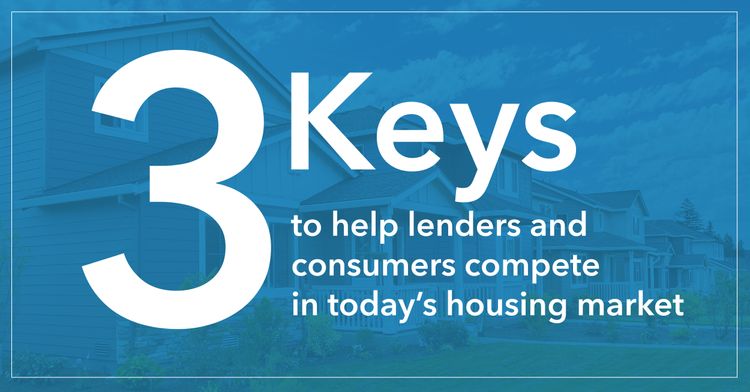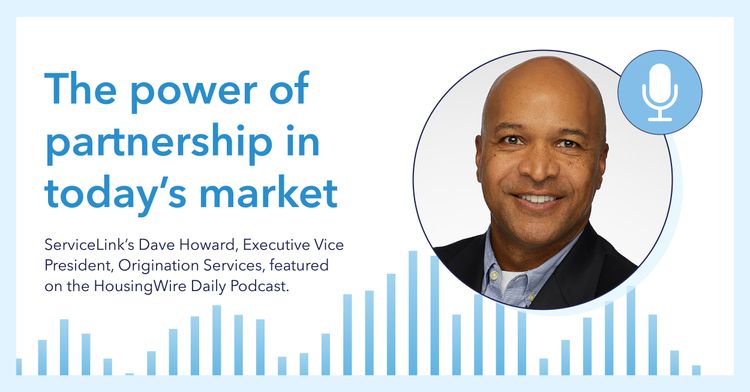We’re currently living in a unique snapshot in time regarding the housing and mortgage markets. Considering housing volume and pricing, interest rates and other variable factors, today’s buyers and lenders must be agile and ready to seize on opportunities when they arise.
The following points are the top takeaways from a recent conversation with three prominent mortgage industry experts from ServiceLink and NAMMBA. Their commentary, which was centered on homebuying trends, was part of a webinar titled, “The State of Homebuying: Buyers’ Desires, Dealbreakers and Outlook in 2024.” This conversation provided not only impactful insights for borrowers, but real-time action items for lenders looking to stay competitive in the current market.
Takeaway #1:
“The [mortgage] rate barrier is a bit of a psychological barrier,” says Dave Howard, executive vice president, origination services, ServiceLink.
For buyers, there are many considerations that go into purchasing a home, and one of the key factors is the mortgage rate. During the pandemic, the average 30-year mortgage rate dropped to as low as 2.65% in January of 2021. In comparison, rates were up around 7.03% in December of 2023.
“If you look back at the pandemic boom of low rates, it’s the rate of change that people missed out on that’s really giving them a pause to jump in and compete in the marketplace,” says Howard.
Borrowers are well aware of this truth: the higher the rate, the higher the monthly payments. It’s no surprise that affordability was ranked as a top concern among respondents in the 2024 ServiceLink State of Homebuying Report (SOHBR). Home prices have certainly appreciated greatly over the years, but for those concerned about mortgage rates in particular- do they have to be the nail in the coffin?
“I always say marry the house, date the rate,” says Miriam Moore, president of default services, ServiceLink. Miriam’s point is that mortgage rates ebb and flow, which means there are opportunities to capture (such as refinancing when rates go down). She says that while the prospect of a better rate may be available in the future, the perfect home that just went on the market may not.
Howard agrees and says ultimately when it comes to buying a home, it should be more of a personal long-term financial decision and less about current fluctuating rates. He’s a firm believer that the value of homeownership and the opportunity to build wealth outweighs variable market conditions.
Takeaway #2:
“[Lenders] should begin to truly look at other platforms where [borrowers] are spending their time and then introduce your brand through financial engagement, financial literacy and financial education to let them know who you are, what you do and your commitment to helping them own a home,” says Tony Thompson, Founder and CEO of NAMMBA.
The first step in this process is understanding who makes up today’s contingent of buyers. The SOHBR found that the most likely buyers in ’24 will be made up of a combination of Gen Z (born between 1997-2012) and millennials (born between 1981-1996). Not only are they the most eager to purchase, but these younger generations have the most optimistic outlook on the market.
“They spend 6-9 hours a day on social platforms. That’s where most lenders will need to pivot in terms of their outreach efforts,” Thompson says.
Truly understanding where this group of buyers spend their time will help lenders narrow and maximize their marketing dollars. Thompson says, for example, the younger generation is much more apt to scroll through TikTok than LinkedIn for housing information. He says getting to know the online habits of key demographics should be a consideration when lenders develop their outreach and education strategy.
“Lenders [need to] realize that we have to start looking at putting people at the top of our funnel,” Thompson says. “There’s going to be a longer cycle time in terms of getting someone from engagement to the closing table, so that education piece is becoming very critical.”
In terms of education, Thompson suggests lenders concentrate on providing content in three main buckets: the benefits of homeownership, what the journey entails and how to start the process. He says these resources should go beyond just articles on a lender’s website, they should be dynamic, informative and available across websites and social platforms.
But what happens once a lender captures this desired demographic? Thompson says it’s not just about getting a borrower’s attention but being able to serve and support their diverse needs.
“Take a look at your sales staff and make sure you have language capabilities, as well as in-person and outreach initiatives to connect and engage at a local level,” says Thompson.
Takeaway #3:
“This younger generation needs to think about their expectations … and perhaps temper expectations of their dream home,” says Moore.
As of September 2023, Redfin reports the median home price in the U.S. was $412,000. That’s a good chunk of change for anyone, let alone first-time and younger homebuyers. Home prices have increased 5.5% year-over-year and inflation continues to drive up costs. Findings from the 2024 SOHBR survey show that among Gen Z respondents, their biggest desire is a larger home with plenty of space, while millennials are more likely to seek a home with tech upgrades and amenities.
“It's very, very difficult for everyone to temper those expectations because we are pumped into on a daily basis [whether it be] online, television, etc. that our expectations should be at the top. The top meaning brand new home with all new amenities where remodels get done in an hour,” says Howard.
So, for those newbies without loads of cash in their pockets, Moore says it might be time to reprioritize and consider a starter home that could use a little TLC. A fixer upper traditionally has a lower price point than a move-in ready home, so Thompson adds between the cost savings from a cheaper home and current lender incentives, there are opportunities to be seized. “One of the most important tools that homebuyers have that allows them to afford as much house as they can is the use of down payment assistance programs,” says Thompson. “These are excellent tools in most markets, both at the state level as well as at the local, city and county level.”
In addition to leveraging buyer assistance programs, Moore reminds buyers that auction properties are an alternative source that could be considered. With its tech-forward bidding model and the opportunity to potentially snag a property at a lower price point, today’s homebuyers have options if they know where to look.
To tap into the full conversation, and to download the 2024 State of Homebuying Report, visit: go.svclnk.com/state-of-homebuying-report-2024.


